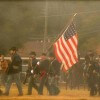“Verily, Sherman made war horrible”
General William Tecumseh Sherman’s March to the Sea was intended to divide the Confederacy, cut enemy supply lines, and destroy the will of the civilian population that supported the war. The battle and occupation of Sandersville provides an excellent example of how Sherman’s March proved to be utterly devastating to those in its path and is reflective of the experience of other rural communities in Georgia.
On November 16, 1864, General Sherman left the battlefield of Atlanta with over 62,000 men, who were divided into two wings, the left and right. While both wings held a fairly central course towards Savannah, the left wing took the northern route of the March to the Sea, while the right covered the southern. In late November, both wings descended on Washington County, which made for the first time both were in the same county since marching out of Atlanta.
After having captured Milledgeville a few days earlier, the left wing marched towards Sandersville with General Sherman traveling with the 20th Corps. The right wing, coming from Irwinton, was assigned the task of destroying railroad tracks along the way. Confederate troops under General Joseph Wheeler had slowed the movements of the 20th corps by destroying the bridges over Buffalo Creek. Sherman was furious. The bridges were rebuilt and on the afternoon of November 25th, Wheeler’s troops fought the Federals near the creek. Wheeler, realizing that advance of the enemy into Sandersville to be inevitable, sent warning to the citizens to be prepared for invasion.
The evening of November 25th, the citizens of Sandersville were confronted with General Wheeler’s entrance into town with 13 Union prisoners of war, who were housed in a makeshift prison. Early the next morning, Rev. J. D. Anthony, pastor of the Methodist Episcopal Church, learned that twelve of the prisoners “had disappeared during the night except one, a lieutenant of cavalry, who was badly wounded in the left forearm”. That prisoner, a member of an Illinois regiment, was entrusted into the care of Rev. Anthony and taken to his home. The missing twelve were shot by an unknown group and buried under the cover of darkness. Fear of retribution by the Yankees abounded in town. Plans were made for Rev. Anthony to peacefully surrender the town to the invading army, but Anthony recorded “there was no opportunity afforded”.
The Battle of Sandersville
In the early morning hours of November 26, the left wing’s 14th and 20th corps entered Sandersville nearly simultaneously and encountered resistance from Wheeler’s cavalry. The Rebel soldiers fired from the courthouse, street corners, and houses. Major James Connolly of the 14th noted that while Sandersville was the scene of the “first show of opposition the left wing of the grand army has yet met with, that opposition was easily overcome by the larger force”.
One federal was killed and 11 were wounded. Wheeler’s men suffered one casualty, a Private John R. Brunson of the 6th Tennessee Cavalry Regiment. He died in the vicinity of West Church street and was buried by the Union Army near the Methodist Church in what is now Old City Cemetery. Historical accounts tell us that he was given a “mock” funeral by Sherman’s army. He was 30 years old and left behind a wife and two small children. In 1866, his wife Mary wrote a poignant letter to the ladies of Sandersville thanking them for caring for her husband’s grave.
“The army will forage liberally on the country during the march”
After the retreat of Wheeler’s cavalry, Sandersville was subjected to Sherman’s policies of liberal foraging and free appropriation. What had just the day before been a town of plenty was quickly depleted of its food supplies. Personal property was looted or destroyed. One Federal soldier recorded, “The boys were allowed to do just as they pleased. We had fought for the town and it was our plunder. The town was completely ruined, then burned”. Ella Mitchell’s home was one of many raided. She recorded, “In a little while there was not a piece of china, silver, or even the table cloth left, and the food disappeared in a second. Fences were torn down, hogs shot, cows butchered, women crying, children screaming.” Henry Hitchcock of General Sherman’s staff reported that the General had planned to burn down the town as retribution for the execution of the prisoners of war, the destruction of the bridge, and the military resistance encountered. Rev. Anthony met with Sherman at his temporary headquarters near the Brown House to plead for the town. Whether it was Anthony’s use of the Mason’s “grand hailing sign of distress ” or the Reverend’s final appeal “for the shelters over the heads of these innocent women and children, whose husbands and fathers are either in the field or fallen in battle. Your soldiers have already taken all we have to eat. Now, if you burn our houses, what can save these people from starvation and death?”, the General capitulated. The courthouse, jail, barns and a factory were destroyed on the morning of November 27th, but the town was not razed. Anthony noted that “it was with great difficulty that the buildings were prevented from burning down”.
Far From Home
That morning, Sherman met his right wing in Tennille, 4 miles south of Sandersville, to witness the destruction of its rail lines. The left wing marched 12 miles to the hamlet of Davisboro. Meanwhile, Private Joseph W. Harrison of the 59th Georgia Regiment was camped somewhere in Virginia. On December 2nd, he wrote to his mother of the Agricola Community, 8 miles north of Sandersville, anxiously requesting news from home. He had heard of the movements of the Federals through Washington County. On December 25th, his anxiety still raged with no word yet on the fate of his family. Those fretful feelings must have been heightened after he was presented that day with the news that, ” the Yankees have taken Savannah”, but he “hope(d) that is not so”.
It is likely that his family was faring better than the residents of Sandersville. As the nighttime gathered over Sandersville on November 27, 1865, the arduous process of rebuilding had yet to be conceived in the shocked minds and hearts of its people. Ella Mitchell described the thoughts of her friends and neighbors with a few simple words, “Verily, Sherman made war horrible”.
Private Harrison’s poignant letter can be read here https://occupationofsandersville.org/letter/



